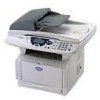Brother International DCP 8045D Network Users Manual - English - Page 116
Using DHCP to Con the IP address, The Dynamic Host Configuration Protocol DHCP is one of several
 |
UPC - 012502610335
View all Brother International DCP 8045D manuals
Add to My Manuals
Save this manual to your list of manuals |
Page 116 highlights
Using DHCP to Configure the IP address The Dynamic Host Configuration Protocol (DHCP) is one of several automated mechanisms for IP address allocation. If you have DHCP Server in your network (typically a Unix/Linux, Windows NT® 4.0, Windows® 2000, XP or Novell Netware network) the Print/Fax server will automatically obtains its IP address from DHCP server and register its name with any RFC 1001 and 1002-compliant dynamic name services. If you do not want your Print/Fax server configured via DHCP, BOOTP or RARP, you must set the BOOT METHOD to static so that the Print/Fax server has a static IP address. This will prevent the Print/Fax server from trying to obtain an IP address from any of these systems. To change the BOOT METHOD, use the machine's control panel, a Web browser or by using the BRAdmin Professional utility. Using APIPA to Configure the IP Address With Automatic Private IP Addressing (APIPA), DHCP clients automatically configure an IP address and subnet mask when a DHCP server is not available. The device chooses it's own IP address in the range 169.254.1.0 through to 169.254.254.255. The subnet mask is automatically set to 255.255.0.0 and the gateway address is set to 0.0.0.0. By default, the APIPA protocol is enabled. TCP/IP CONFIGURATION 11 - 5















